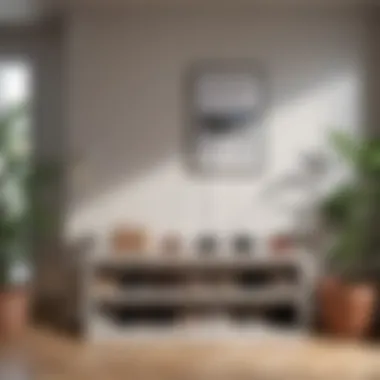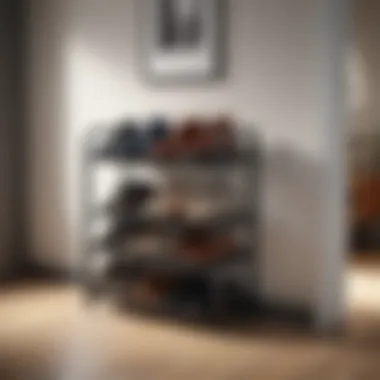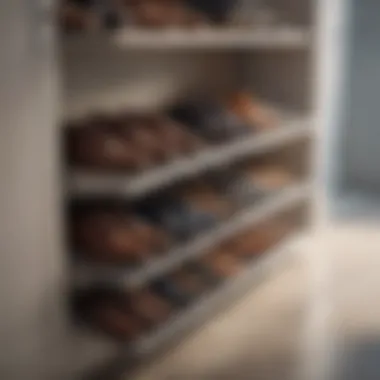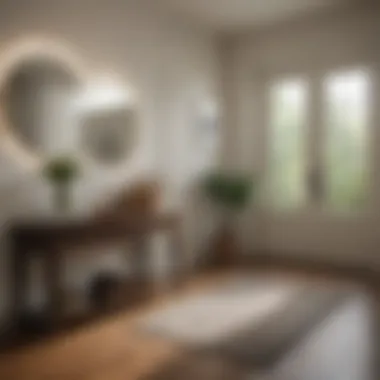Mastering Shoe Organization at Your Front Door


Intro
A well-organized entryway is more than just a practical part of home management; it is a reflection of personal style and a crucial aspect of daily living. Shoes tend to accumulate quickly at the front door, creating disorder. This article aims to provide homeowners and design enthusiasts with a thorough understanding of effective shoe organization. By exploring various strategies and materials, we will help you create a clutter-free and aesthetically pleasing entrance.
Key Insights and Trends
Current Trends in Interior Design
One notable trend in interior design is the emphasis on minimalism. Many are moving towards decluttered spaces, making shoe organization an essential part of this trend.
- Open Spaces: The desire for open and airy environments encourages homeowners to organize their shoes in ways that look tidy yet still accessible.
- Eco-Friendly Materials: Sustainable options, such as bamboo and recycled plastics, are gaining popularity in shoe storage solutions. This approach aligns with the increasing interest in environmentally friendly home products.
- Multifunctionality: Furniture that serves multiple purposes, such as benches with under-seat storage for shoes, is also a prominent trend.
Popular Strategies for Shoe Organization
Homeowners should consider various strategies to achieve a functional entryway. It includes:
- Cubby Storage: A cubby system can provide an organized space for each family member's shoes.
- Over-the-Door Racks: Maximizing vertical space is a clever way to keep shoes off the ground while remaining easy to access.
- Clear Bins: Using transparent bins allows for quick identification and adds to the aesthetic appeal without sacrificing practicality.
"An organized doorway creates an atmosphere of calm and order before you even step into the rest of your home."
Practical Tips and How-To Guides
Step-by-Step Guide for Organizing Shoes
To achieve effective shoe organization, follow these simple steps:
- Assess Your Collection: Review your current shoe collection. Determine what pairs you use regularly and which can be donated or discarded.
- Choose an Organization Method: Decide on a storage method that fits your style and space. Whether it’s a bench with hidden storage or an open shelf, choose what feels right for your entryway.
- Assign Spaces: Allocate specific spaces for each family member. This can prevent shoes from piling up.
- Invest in Quality Solutions: Look for durable and attractive storage units that match your home’s decor. Products like the mid-century modern shoe rack by Nordstrom or the sleek entryway bench from Home Depot are solid choices.
- Maintain Regularly: Schedule periodic cleanups to ensure the shoe arrangement remains functional and tidy over time.
Entertaining Tips for a Welcoming Entryway
For those who often host gatherings, consider these tips to enhance your entryway:
- Delegate Footwear: Encourage guests to remove shoes upon entering, providing a designated space for theirs.
- Offer Stylish Slippers: Keep a selection of guest slippers handy as a comfortable alternative.
- Keep Essentials Visible: Hang a small basket near the door for storing small items like keys, sunglasses, or masks.
Preface to Shoe Organization
Effective shoe organization is vital for a well-functioning entryway. Shoes are a common source of clutter, and without a proper system in place, they can quickly overrun your space. Organizing shoes at the front door not only reduces chaos but also enhances the overall aesthetic appeal of your home. A clutter-free entrance sets a positive tone for guests and creates an inviting atmosphere.
The Role of Shoe Organization
Shoe organization plays several critical roles in home management. Firstly, it promotes cleanliness. By providing a designated area for shoes, dirt and debris are kept in check, preventing them from spreading throughout the home. Secondly, it enhances functionality. When shoes are organized, it’s easier to find the pair you need, streamlining your daily routine.
Another important aspect is the visual element. A neatly organized shoe area can serve as a design feature. You might use stylish shoe racks or cabinets that complement the decor of your entryway. This adds to the overall style of your home rather than detracting from it. Furthermore, thoughtful shoe organization can reflect personal style, showcasing not just the shoes you own but also how you curate your space.
Assessing Your Entryway Space
Before diving into shoe organization techniques, it’s essential to assess the available space in your entryway. Take a moment to observe how much room you have. Consider factors such as the size of the door, the flow of foot traffic, and any existing furniture and decor. This assessment will allow you to visualize how to integrate a shoe storage solution that fits seamlessly into your home.
You should think about the following:
- Dimensions: Measure the width and height of your entryway. Understanding these measurements will guide your storage choices.
- Foot Traffic: Observe peak times when your entryway will see the most activity. This will help you prioritize accessibility.
- Existing Elements: Analyze what is already in place. Are there hooks for coats or benches for sitting? Make sure your shoe solution complements these elements.
Taking these factors into account ensures that any shoe organization strategy you implement is practical and tailored to your specific environment. With a clear understanding of your entryway, you can move forward with determining the right shoe storage solutions that will enhance both functionality and style.
Types of Shoe Storage Solutions


Effective shoe storage is crucial for an orderly entryway. The choice of storage solution influences both the look and feel of your space. Various options cater to diverse needs, so it is essential to analyze each type's features, benefits, and limitations. Proper organization not only reduces clutter but also makes it easier to find the right pair of shoes when in a hurry.
Shoe Racks
Shoe racks serve as a fundamental component in shoe organization. They come in various designs, fitting different entryway aesthetics and space requirements.
Open vs. Closed Design
An open shoe rack is popular due to its accessibility. Its primary feature is that shoes remain visible, which aids quick selection. On the other hand, closed designs offer concealment, which can contribute to a cleaner look. The benefit of an open rack is that it encourages airflow around shoes, helping them remain fresh. However, it can also attract dust. Closed racks keep dust at bay and maintain a more polished appearance, yet may restrict airflow, leading to odor. Therefore, the choice greatly depends on individual preferences regarding visibility and maintenance.
Material Considerations
Material choice in shoe racks plays a significant role. Common materials include wood, metal, and plastic. Wood offers warmth and sturdiness, making it a favored option for aesthetic coherence in home decor. Metal is often more sturdy but may lack the warmth of wood. Plastic offers lightweight convenience, but might not suit every design space. Each material provides different levels of durability and maintenance needs, making understanding these differences essential for an informed choice.
Shoe Cabinets
Shoe cabinets are designed for those seeking a blend of storage and decor. They come in various styles and size options.
Size and Capacity
When selecting shoe cabinets, considering size and capacity is paramount. A larger cabinet can accommodate a significant number of pairs, making it ideal for families or shoe enthusiasts. However, it requires sufficient space in the entryway. Smaller cabinets suit limited spaces but may compel users to be more discerning about their shoe collection. The capacity ultimately affects how organized the space remains.
Style Compatibility
Style compatibility is another vital element. Shoe cabinets should harmonize with the overall design of the entryway. Whether modern, traditional, or minimalistic, the cabinet should feel like an integral part of the decor. This approach ensures that the cabinet does not just serve a functional purpose, but also enhances the aesthetic value of the entryway. Proper alignment in style and functionality adds to the entryway’s visual appeal.
Under-Bench Storage
Utilizing under-bench storage is an effective strategy for maximizing space. A bench offers seating while providing a functional area for shoe storage.
Maximizing Space
Choosing storage solutions that fit under a bench makes use of otherwise wasted space. It is an excellent option for smaller entryways where every inch counts. This setup can include pull-out trays or cubbies, allowing for easy organization of shoes. The efficient use of space helps maintain a tidy appearance, especially in busier households.
Ease of Access
Ease of access is another advantage of under-bench storage. Items stored here are often simple to reach when in need. This quick access can be useful for busy mornings. However, if the area is overcrowded, locating the desired shoes can become complicated. Ensuring a system of organization underneath the bench is key to maintaining functionality.
Hanging Organizers
Hanging organizers can be particularly advantageous in maximizing vertical space, which is often overlooked.
Over-the-Door Solutions
Over-the-door solutions are effective for smooth organization without sacrificing floor space. They utilize vertical height, hanging securely on the door for easy access to frequently used shoes. The benefit of this method is that it keeps shoes organized without taking away valuable space. However, they may not accommodate larger shoe sizes well, making selection limited.
Vertical Space Utilization
Vertical space utilization can transform an ordinary entryway into a highly functional area. By using hangers or large pockets, homeowners can store a variety of footwear while keeping them visible. This method not only enhances accessibility but also allows for better organization. Remember that while this option works well for casual shoes, it may be less suitable for bulkier items like boots.
Designing an Aesthetic Shoe Storage Area
Designing an aesthetic shoe storage area is vital for both functionality and visual appeal. It transforms a cluttered entryway into a well-organized space that reflects personal style. The arrangement of shoe storage should not only accommodate multiple pairs of footwear but also harmonize with the overall design of the entryway. An aesthetically pleasing area enhances the welcome feel of the home and influences the first impression of visitors.
Color Coordination
Matching with Entryway Decor


Matching shoe storage with entryway decor is essential for cohesive design. This ensures that the area complements the existing color palette, which is important for a unified look. A key characteristic of this approach is that it allows for self-expression while maintaining a sense of order. For instance, if the entryway is decorated with neutral tones, a shoe rack in a similar shade can blend seamlessly. This choice is beneficial because it avoids visual disruption.
The unique feature of this matching process lies in its ability to create a harmonious environment. With carefully chosen colors, the shoe storage can enhance the visual harmony of the space. However, be cautious about going too bold with colors that clash. Poor color coordination could lead to a chaotic appearance, defeating the purpose of organization.
Creating Visual Appeal
Creating visual appeal involves strategically selecting designs and styles that attract the eye. Well-organized shoes can themselves be a part of the decor when showcased properly. A prominent aspect of this strategy is utilizing various textures and design styles to create interest. This is a beneficial choice because it draws attention and can even spark conversation.
The appeal comes from the arrangement and presentation of the shoes. Displaying them in a chic, organized manner can elevate the entryway. It is important to ensure that while focusing on aesthetics, the functionality does not take a back seat. Overly complex designs might hinder easy access and usability, so balance is needed here.
Incorporating Decorative Elements
Using Plants and Art
Incorporating plants and art can significantly enhance the aesthetic of shoe storage areas. This strategic inclusion adds greenery and life to the space. Plants are beneficial because they improve air quality and contribute to a calming atmosphere. Art pieces can range from small wall hangings to sculptures, making the area uniquely personal.
A unique feature of using these elements is their versatility. They can be adjusted or changed based on seasons or personal preferences. However, one might face challenges with maintenance; plants need care, and artwork must be protected from shoe-related wear. So, it is essential to weigh the benefits against potential upkeep.
Integrating Lighting
Integrating lighting into the shoe storage area is crucial for both functionality and ambiance. Adequate lighting makes it easier to find shoes quickly, especially in darker entryways. A key characteristic of effective lighting is its ability to highlight the shoe display and create an inviting atmosphere. Using warm light can enhance the visual appeal, making the space feel homely and welcoming.
The unique aspect of this integration is the potential for different types of lighting. Options include overhead fixtures, wall sconces, or even LED strips under shelves. Each option has its advantages, such as adjustable brightness or color temperature. However, be careful to not over-illuminate, which could wash out the space and detract from its design.
Functional Aspects of Shoe Organization
Understanding the functional aspects of shoe organization is crucial for maintaining a balanced entryway. Efficiency and safety are two key elements. Proper organization limits clutter and enables easy access to necessary footwear. This reduces stress during busy times, when haste typically leads to disarray. An aesthetically pleasing arrangement also turns a mundane entryway into a welcoming space. Thus, focusing on function is important to enhance daily routines.
Ease of Cleaning
Choosing Materials that Resist Dirt
Materials that resist dirt play a significant role in ease of cleaning. Selecting such materials can significantly reduce the effort needed for upkeep. For example, plastic or rubber shoe racks are often popular choices. They are durable and easy to wipe down, making them practical for daily life. The unique feature of these materials is that they do not trap dirt, thus promoting a cleaner environment. However, they may lack the aesthetic appeal of wooden options, which can be a consideration for some homeowners.
Designing for Maintenance
Designing for maintenance often involves selecting user-friendly designs for storage solutions. A well-thought-out organization plan minimizes the need for frequent cleaning or adjustments. For instance, shoe storage systems with removable bins ease the process of cleaning. With this design, homeowners can easily empty and clean the bins when necessary. This characteristic makes it a favorable choice, as it fosters both cleanliness and organization. Yet, these systems can sometimes take up more space compared to fixed designs.
Safety Considerations
Tipping Hazards
Addressing tipping hazards is essential in ensuring a safe entryway. Unstable shoe racks can pose risks, especially in homes with children or pets. A significant characteristic of safer shoe storage is a low center of gravity. Low-profile storage solutions reduce the chances of tipping over under weight. This safety aspect is particularly beneficial as it minimizes accidents and injuries in busy households. However, these designs may limit vertical storage options, which could impact space efficiency.
Managing Clutter During Busy Times
Managing clutter during busy times is critical for the functionality of the entryway. With high foot traffic, shoes can easily accumulate, leading to chaos. One way to manage this is to implement a daily shoe return practice, where everyone places their shoes back in designated spots. This system, requiring minimal time, helps maintain order even during hectic moments. However, it relies on consistent participation from all household members, which can sometimes be challenging.
Effective shoe organization directly impacts the overall atmosphere of the home.
In summary, focusing on the functional aspects of shoe organization not only enhances daily efficiency but also promotes safety and cleanliness in the entryway. By making thoughtful choices about materials and designed practices, homeowners can create a space that is not just organized but also harmonious.
Seasonal Shoe Organization Strategies
Effective shoe organization is not just about tidiness; it also considers the seasonal changes that affect what footwear you need readily available. Seasonal shoe organization strategies assist in maintaining an orderly and efficient entryway. Understanding how to store and manage shoes according to the seasons helps homeowners save space and extend the lifespan of their footwear. These strategies are essential particularly in regions with distinct seasonal climates—where summer sandals and winter boots require different care and storage methods.


Winter vs. Summer Shoes
Storage for Boots
Boots are essential during the colder months. Proper storage for these larger items is crucial for protecting them from damage and keeping the entryway organized. A designated space that is both accessible and does not impede movement is necessary. The key characteristic of effective boot storage is its capacity. Boot racks or bins often have taller compartments, allowing boots to stand upright.
A popular choice for storing boots is a vertical boot rack. This type offers good ventilation and reduces the risk of mold or mildew developing. The unique feature of vertical boot racks is that they maintain the shape of the boots. This is fundamental in preserving their appearance and functionality. One disadvantage, however, is that they can take up more space compared to horizontal options.
Managing Sandals and Sneakers
For warmer seasons, managing sandals and sneakers requires a different approach. These shoes typically take up less space and are often lighter. The key characteristic here is versatility. Storage methods can range from simple shoe bins to more decorative solutions like baskets. Managing these shoes efficiently enhances the overall organization of the entryway.
One common choice is using a multi-tiered shoe rack. These racks allow for easy visibility and access to footwear essentials, promoting quick decision-making on what to wear. The convenient aspect of this approach is its accessibility; you can quickly grab a pair without any hassle. However, a limitation might be that it does not provide much protection from dust or dirt without an overhead cover.
Rotating Seasonal Storage
Establishing a Rotation System
Establishing a rotation system helps in managing shoe inventory. This system entails regularly moving seasonal shoes in and out of everyday accessibility. The primary advantage is clear organization and easy access to relevant footwear. A rotation system typically involves keeping current shoes at the forefront while older seasonal items are stored out of sight.
This method allows homeowners to adapt to changing needs throughout the year. Creating a simple checklist can help in ensuring that all necessary steps are taken when rotating shoes. One potential drawback is that this may require regular maintenance and attention, which could become tedious over time.
Maximizing Space Utilization
Maximizing space utilization is another fundamental aspect of seasonal shoe organization. Employing strategies like under-bench storage or collapsible bins can free up valuable areas in an entryway. The essential characteristic of space maximization is that it takes into account vertical and horizontal space. This allows homeowners to utilize every inch efficiently.
For instance, under-bench storage can seamlessly integrate into existing furniture while maintaining aesthetic appeal. Additionally, collapsible containers provide the flexibility to adjust the storage setup as needed. However, a downside is that space optimization may come with limits if the entryway is too small, potentially compromising accessibility.
By combining various seasonal shoe strategies, homeowners not only embrace organization but also contribute to a more functional and visually appealing entryway.
Maintaining Your Shoe Organization System
Maintaining an organized shoe system is crucial for ensuring that a tidy entryway becomes a sustainable feature of your home. A well-maintained organization system not only minimizes clutter but also enhances the efficiency of daily routines. When shoes have dedicated places, it encourages family members and guests to follow suit. This promotes a culture of order and elegance in and around the front door.
Regular Assessment and Adjustment
Identifying Underused Items
Identifying underused items is a vital aspect of maintaining shoe organization. Some shoes may seldom be worn, taking up valuable space. By assessing which pairs are rarely used, homeowners can decide to store them away or even donate. This practice helps create a more streamlined and functional entryway.
A significant characteristic of this approach is the adaptability it offers. It allows for a dynamic organization system that reflects your current lifestyle. The unique feature here is the ability to periodically reassess your footwear needs. As seasons change or life circumstances shift, some shoes may become more or less relevant. The advantage of this method is that it keeps shoe storage manageable and purposeful, avoiding waste.
Adapting to Changing Needs
Adapting to changing needs is equally important in maintaining a shoe organization system. As lifestyles evolve, so do shoe preferences. In a busy household, for example, someone may find that their needs shift from formal to more casual footwear. This is where adaptability shines as a key characteristic of effective shoe management.
This unique feature allows for timely adjustments in storage solutions and practices. The advantage of being keen to change is that it prevents stagnation in your organization system, keeping it relevant. Having a responsive system caters to both your evolving tastes and practical necessities, ensuring that accessibility remains intact.
Establishing a Shoe Management Routine
Daily Practices
Daily practices are essential in maintaining shoe organization. Establishing habits, like putting shoes back in their designated places after use, creates a culture of accountability. This is beneficial because it minimizes the chances of chaotic clutter at the front door.
A unique feature of daily practices is consistency. By incorporating small routines into everyday life, it becomes effortless to maintain an organized space. The advantage of this method is that it promotes the longevity of the organization system; the more it is practiced, the more natural it becomes.
Accountability Measures
Accountability measures reinforce the importance of maintaining your shoe organization. Creating a system where family members are responsible for their own footwear can enhance personal responsibility. This approach is beneficial for fostering a collective commitment to maintaining order.
The distinctive feature lies in establishing check-ins or reminders about the organization system, which keeps everyone engaged. The advantage of accountability is that it encourages each member to take pride in their contribution. Ensuring that everyone is vested in the system leads to higher compliance and sustained order.
"An organized entryway is a reflection of the order in one's life, inviting a sense of calm within the chaos of daily routines."



